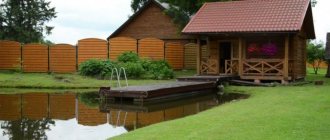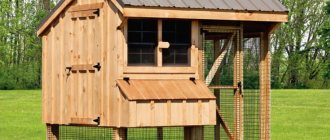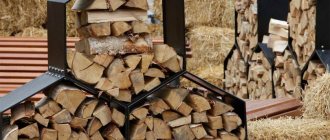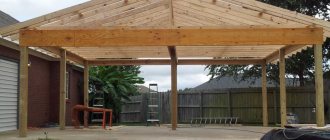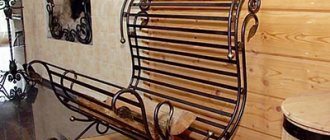Which options are more common than others?
Stationary chicken coops are a standard building for summer or permanent residence.
Chicken coops are similar in appearance to a cottage with an attic and have a pair of boards in their design, thanks to which it can be moved from place to place.
A chicken coop in the form of a wheelbarrow, where the “house” is connected to a single-axle frame with wheels. Used to move around a small area.
Chicken coop trailer. For structures with heavy weight, decent dimensions and significant capacity. There is a two-axle trailer that allows you to roll the chicken coop over longer distances compared to other types of mobile chicken coops.
Ready-made chicken coops are common in countries with mild climates, but in our country they can only be used in the warm season. Pros: compactness, ease of assembly and disassembly. Cons: costly purchase, not suitable for every climate.
Despite all the variety of ready-made poultry houses, chicken breeders often prefer to build them themselves.
Projects
The formation of a project begins with drawing up drawings and studying photographs. You can also take ready-made drawings from standard projects. All dimensions and distances must be marked on the drawings; The doors always open towards the inside of the coop. Cleaning will be much easier.
During the design process, you need to find out how much is required:
- drinking bowl;
- places for feeding;
- roosts
They figure out in advance how to heat the chicken coop, how to light it and provide ventilation. Floors are formed from clay or earth. The design of the base depends solely on how large the load is from above. The design must take into account the insulation material used and its layer.
If necessary, do not deviate from standard schemes.
What you need to know before starting construction
It should be remembered that chickens are generally more unpretentious than other poultry: turkeys, quails, guinea fowl, and so on, but to keep them you need to take into account some nuances.
If you are interested in the question “How to build a chicken coop with your own hands?”, then before you start building a bird house, learn a few rules:
For a bird’s comfortable life, the optimal temperature is considered to be from +10 to +20 degrees, since temperatures above or below the stated range can affect egg production in particular and the well-being of chickens in general.
High humidity is destructive, because it provokes the growth of bacteria, the spread of mold and an unpleasant odor, so it is advisable to place the building somewhere higher on the site.
Excessively damp soil must be dried using all sorts of means: tools for removing moisture, or you can fill the area with sand, or create holes or channels to drain water.
It is useful to equip chickens with a shallow pond for bathing procedures, where, by the way, the collected excess water can be redirected.
With a longer daytime period, the egg production of chickens increases. It is recommended to build a chicken coop facing southeast: it is desirable that the door faces east and the windows face south, although it is better to shade them when it is too hot and light.
The room must be well ventilated, but drafts are unacceptable - to protect against them, you can use building materials, as well as hedges.
The construction site should be located where there is no noise, the screams of passers-by or vacationers and passing cars cannot be heard. Peace and quiet are important components for the normal life of poultry;
- Lawn laying
A garage at the dacha is not a warehouse, but a modern and comfortable space!
Diesel generator for home: which one to choose?
Space inside and outside the chicken coop is also important. Crowding can lead to the formation and spread of diseases, pecking and poor or no egg production. “Golden” ratio: two birds per square meter. meter of free space;
The walking area must be provided with lawns, but certainly with shelter from the sun and bad weather.
Dimensions
With all the variety of designs for chicken pens, there are very clear requirements for their selection and use. Thus, structures that are close in shape to a rectangle or exactly correspond to it are oriented from east to west. The usual recommended proportion involves placing 2 chickens per 1 square meter. m. If this space is not provided, egg collection is reduced.
It is important to remember that the population will almost always grow over time. And therefore the need for free space also increases. The required area greatly depends on which adult birds or broiler chickens are planned to be kept. So, for the egg breed this figure is 4 adults. And for those who give, along with eggs, also meat - only 3.
In the vast majority of cases, private chicken coops are designed for 20 or 50 birds. 100 chickens or more are very rare in one place. For every 20 chickens, a minimum of 5 square meters is allocated. m of the main room, and with a walk or vestibule it turns out to be no less than 15 square meters. m. Any of the walls is made with a length of 300 cm. It is along this wall that the nests will be built, which are placed in 4 tiers.
The usual 5 nests will take up approximately 240 cm. In addition to this, you will need to leave a distance of about 0.3 m from the perimeter of the tiers to the walls. This gap greatly facilitates maintenance and subsequent disinfection. The minimum width of any chicken coop is 150 cm. The recommended dimensions change if a design for 50 heads is being considered.
In this option, the area of the main part of the chicken coop is at least 15 m2. The size of the enclosure is at least 20 m2. Nests are placed along walls at least 6 m long. The height of a large farm chicken coop is at least 2 m. This is necessary for convenience.
Ceiling and roof
A gable roof is recommended by many craftsmen, since the attic can be used to store necessary household equipment and feed for chickens. To build it you need:
- Make, fix and strengthen the rafters;
- The process of sheathing, in which the roof is sheathed with any suitable material: slate, tiles, ondulin, roofing felt and the like. It is better that the roof is not “dark”, otherwise it will attract the sun’s rays, which, if ventilation is poor, can cause heat stroke in chickens;
- Strengthening the ceiling beams and arranging the ceiling is the most important thing so that it is reliable and strong.
- It is better to insulate the ceiling using expanded clay or coal slag, which is poured onto the floor. To hide the insulation, it is better to cover it with boards or the same OSB boards.
- Ventilation of the chicken coop, as already mentioned, is very important. In this case, you can make natural ventilation: two ceiling holes placed in places opposite from each other, into which pipes must then be inserted.
Winter insulation of the room
High-quality external insulation of the structure, including window frames and the attic, will help save on heating birds. In this case, the need for internal heating devices will be relevant only on severe frosty days.
To heat such rooms, many summer residents prefer the following options:
- Natural - involves the use of foam plastic (50 mm thick), mineral wool or glass wool. They are recommended to cover insulated surfaces on both sides. Also suitable for these purposes are fiberboard, chipboard, plastic, lining, boards, and plywood. The gaps in the windows and between the joint parts are treated with construction foam, and the board elements are impregnated with a special liquid to protect them from damage and aging. Also, many breeders try to warm their birds with a thick layer of bedding (straw from awnless cereal crops, sawdust, pine needles). On winter days, a layer of about 7–10 cm is recommended. Subsequently, the soiled layer is not thrown away, but sprinkled with a new one. During the process of physicochemical reactions, the decomposition of chicken manure is accompanied by the generation of heat, which helps to maintain the desired level of optimal temperature and disinfect the room. In addition, hay or straw is stored in the attic to save heat.
- Electric - carried out with the participation of infrared heaters, oil radiators or heat fans. Each of the units, to one degree or another, maintains the temperature regime of the room and combats excessive dampness. The only drawback of such heating is its costs. Many owners consider infrared heat lamps to be the most profitable of the listed methods of electric heating of a chicken coop, because during the heating process the room is also illuminated. In addition, such devices justify themselves with a high efficiency factor (98%). They heat not the air masses, but the objects underneath them. But for proper operation, it is important to place them at a distance of at least 0.5–1 m from the heated object. Also, do not forget about fire safety techniques.
- Gas - provide for the presence of gas installations. Beneficial only on large farms. To heat several dozen chickens at the dacha, it is not advisable to buy an expensive boiler. And the system requires constant monitoring,
- Wood-burning - carried out using an ordinary clay stove, potbelly stove or “buleryan”. Each of the devices justifies itself with good heat transfer and ease of operation. However, the installation of such structures requires special attention to compliance with fire safety rules.
- Water - provides for the installation of steam heating, but is relevant only in cases where the chicken coop is adjacent to a residential building. It is necessary to equip the premises with additional pipes. However, even experienced builders will be unable to deal with the upcoming work on their own, so it makes sense to turn to specialists for help.
Did you know? Hindus have long feared chicken because domesticated chickens were considered sacred animals. At the same time, every resident of India hunted their wild relatives.
Chicken coop from the inside
To more accurately understand what kind of “decoration” should be and where it should be located, you can enter the search query “how to equip a chicken coop inside a photo”, but the basic principles are the same:
One of the walls is selected for laying hens and their nests. A shelf is knocked together at a height of a meter, and a ladder is attached to it. This is a spacious board with slats that are nailed horizontally.
The nests are placed on the shelf itself and are usually made from old boxes, or made from leftover boards, plywood, chipboard and other similar materials and straw, which must be cleaned regularly. It is not advisable to use hay, as it quickly rots and rots.
The required number of nests is calculated from the ratio: one to 2-3 hens, which can lay eggs in 2-3 nests, occasionally changing one to another. In summer, it is recommended to arrange roosts on the range. A well-designed chicken coop for laying hens is already 50% of the success of the construction.
Along the remaining perimeter it is necessary to equip perches for sleeping: two sticks are knocked together in the shape of the letter “A” - these are racks - then they are connected on the sides, as well as at the tops, with oblong poles. It is worth considering that one meter is designed for approximately 5-6 small or 3-4 large chickens. Height from floor approximately 50 cm.
Drinkers and feeders are better if they are semi-closed, but with slits for the heads, so the food and water will become less likely to become clogged, and the environment will become cleaner.
It is necessary to install a trough with mixed ash and sand: here chickens can clean their feathers of parasites or dirt.
Microclimate
Most chicken breeds do not tolerate winter cold well, especially since this period often coincides with seasonal molting, when the bird’s body is weakened.
To regulate humidity, temperature and ensure the flow of fresh air in the chicken coop, you need to install ventilation. In winter, chickens need to artificially increase daylight hours - this is necessary to increase their productivity.
Important! You can keep the coop warm by forming high snowdrifts near the outer walls in winter. In the spring, it will need to be removed before the thaw to avoid flooding of the barn.
Ventilation
The type of ventilation must be selected at the construction stage: depending on the dimensions of the building and the number of seats.
There are 3 types of ventilation systems:
- elementary;
- supply and exhaust;
- mechanized.
A basic ventilation system involves ventilation by opening windows and doors. The main task is to position the window openings so that the bird does not suffer from a draft.
It is best to make several fixed windows (that do not open) and one small dormer window with an adjustable sash, which will allow you to regulate the intensity of the air supply.
The essence of the method is that oxygen enters the chicken coop through the door, and carbon dioxide, along with ammonia vapor, is discharged through the window.
This technique can only be used for small livestock (up to 15 heads) kept in a small room.
A supply and exhaust system is the best option for a medium-sized capital building that houses more than 20 chickens.
Involves the installation of supply and exhaust pipes in different parts of the chicken coop. To make it, you need to take 2 plastic pipes with a circular cross-section of 20 cm and a length of 2 m.
Step-by-step instructions for supply and exhaust system equipment:
- Fix the supply pipe so that it is located 35 cm above the roof level, and in the poultry house it is at a height of 25 cm from the floor.
- Attach the exhaust pipe as close as possible to the nesting area so that its lower end is 30 cm from the ceiling, and the upper end rises 1.5 m above the roof level.
- To prevent water from getting into the mechanisms, equip the ends located above the roof level with special metal umbrellas.
- To reduce the risk of room hypothermia, cover the lower end of the supply pipe with a mesh.
The mechanized system is a network-powered fan. The easiest option is to install it in a window opening.
To do this, you need to replace the glass with a sheet of plywood with a prepared hole for the fan. Such ventilation is advisable when keeping more than 40 chickens.
Lighting
Daylight hours for chickens in winter should last 12–14 hours. To ensure this mode, use infrared lamps.
This excellent device will not only help extend daylight hours, but will also act as a heater. Such lamps do not dry out the air, and their soft light has a calming effect on chickens.
Important! Chickens should not extend daylight hours by more than 14 hours, as this will lead to an early decrease in productivity. In winter, the bird needs to regain strength after the active phase of egg production.
Temperature
Infrared heater in a chicken coop
The optimal indoor temperature for chickens in winter is +12...+17°C. Thermometers should be placed in different parts of the chicken coops in order to clearly monitor the temperature and quickly correct the situation if it drops significantly.
If you need to heat a room, it is better to give preference to infrared heaters. They heat the surrounding objects, not the air, so the heat will last longer.
There is no need to overheat the room. +17°C should be the maximum level, otherwise the chickens will start to get sick due to the strong temperature difference when going outside.
Walking area
The matter is not limited to just one “house” - often a chain-link mesh is attached to the chicken coop, creating a unique, safe space for birds to walk:
- A minimum strip foundation is enough to install support pipes.
- As soon as the solution has hardened, a mesh is stretched between the columns - it is recommended to stretch it over the platform - and they also add a roof or some additional shelter that can protect the chickens from the sun or rain, for example.
If you take into account at least a small part of the above tips and tricks, you can build with your own hands not only a “simple” summer chicken coop, but also an “insulated” winter chicken coop.
What are the benefits of backyard chickens?
And in fact, chickens, unlike many other poultry, feel best in winter frosts. They do not need ponds like geese and ducks, and they do not require too much space to live, like turkeys or pheasants.
Chickens are practically omnivores, and in the summer they can eat all sorts of insects on the street, which will not only enrich their diet, but also bring significant savings to the poultry farmer. But this, of course, does not mean that they should live on the street or in some kind of barn that is absolutely not intended for the full-fledged habitat of any animals.
Content Tips
Birds need to be accustomed to a daily routine by timely feeding and walking.
Finally, here are some tips on keeping birds:
- Their breeding should begin with the simplest, unpretentious breeds
- when purchasing chickens, provide them with a comfortable temperature of 29–30 °C; the worst thing for them is hypothermia; purchase a heater or lamp for heating
- use only recommended food for feeding and provide the chicks with enough water
- early walking for chickens is undesirable; start releasing them gradually as they grow, for a short time
- in a small room, chickens will start fighting for space
- for large meat breeds of chickens, replace perches with bedding
- mold and mildew are the main causes of death, ensure high-quality ventilation in the room
- To prevent predators from accidentally getting into the chicken coop, close the doors of the room at least with a latch at night, even in the summer; also cover all ventilation openings with mesh
- provide the birds with a daily routine: feed them 3-4 times a day at regular intervals and let them out for a walk at the same time
- in hot weather, provide them with more water than usual
- overfeeding and underfeeding are equally harmful; for 1 adult it is necessary to give 140 g of food at a time, in winter a little less - 120 g
VIDEO: Setting up a chicken coop - practical tips
Building a chicken coop: description, tips, arrangement of premises for 5, 10 and 20 chickens (105 Photo Ideas) + Reviews
Beautiful examples
A modern chicken coop is not just a utilitarian product, it must be elegant. Only careful integration into the design allows you to avoid emotional inconvenience. The photo below shows a small wooden chicken coop with a gable green roof. The attractive alternation of convex wooden parts and depressions makes the appearance more original. And even the windows are not simple, but divided crosswise into 4 parts.
And here a more classic and balanced solution is shown. The developers were clearly inspired by pastoral landscapes and rural houses. That's why they preferred the characteristic style of the entrance, walls, and roofing made of metal tiles. The colors were chosen as calm as possible, even an imitation of a chimney was created. The part reserved for the enclosure is fenced with a net.
A simpler option is with two rectangular windows on the facade. The roof is raised above the wall, so this solution can be considered more suitable for summer. The top with one slope is directed back, which facilitates the outflow of rainwater.
This original approach is also worthy of attention - a chicken coop, complemented by a ladder. The size allows us to say that this is a structure for a small number of birds.
Sources
- https://Trizio.ru/kuryatnik-svoimi-rukami-kak-sdelat-80-foto-891
- https://landshaftadvice.ru/kuryatnik/
- https://krrot.net/kyryatnik-svoimi-rykami-foto/
- https://zverovod.info/kury/obustroystvo-kuryatnika.html
- https://stroy-podskazka.ru/saraj-dlya-kur/chertezhi-i-stroitelstvo/

